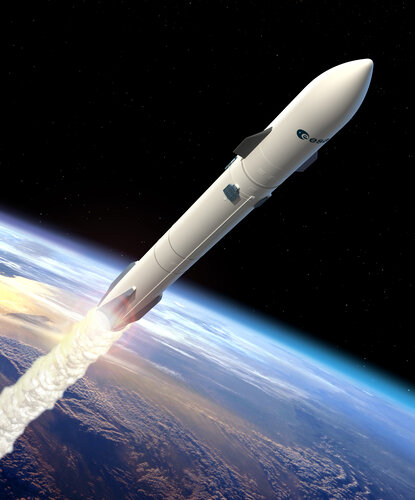
Copernical Team
Smile's other half arrives | Let’s Smile (action snippet)
 Video:
00:01:22
Video:
00:01:22
On 9 December 2024, the Smile Platform arrived safely at Amsterdam Schiphol airport and was subsequently transported to ESA's European Space Research and Technology Centre (ESTEC) in Noordwijk, the Netherlands. It came a long way, having travelled all the way from Shanghai, China.
This marks an important step in the Smile mission, as the spacecraft's two halves are now in the same location, ready to be joined together. Launching in around a year from now, Smile will study space weather and the interaction between the solar wind and Earth’s environment.
The Platform, built by the Chinese Academy of
Pathfinder activity to pave the way for European very heavy reusable rocket

ESA to support Indian human spaceflight missions

On 4 December 2024, the European Space Agency (ESA) and the Indian Space Research Organisation (ISRO) signed an agreement that will see ESA provide ground station support to the missions in ISRO’s Gaganyaan human spaceflight programme.
High-altitude balloon ride offers new perspective for CAIRT

A novel sensor that simulates the measurements that would be taken by one of the proposed satellites vying to be ESA’s eleventh Earth Explorer, has endured an extraordinary journey.
Carried aboard a high-altitude balloon on a four-day voyage from Sweden to Canada, the sensor provides new data that could help to refine the CAIRT mission concept – a mission that aims to unravel the complexities of Earth's atmosphere and enhance our understanding of climate dynamics.
Pentagon secures multi-band satellite services from SES Space and Defense
 SES Space and Defense, a wholly-owned subsidiary of SES, has secured a five-year Blanket Purchase Agreement (BPA) worth up to $117 million. Awarded through Space Systems Command (SSC) with support from the United States Space Force's Commercial Satellite Communications Office (CSCO), the agreement aims to enhance satellite communication capabilities for the United States European Command (USEUCO
SES Space and Defense, a wholly-owned subsidiary of SES, has secured a five-year Blanket Purchase Agreement (BPA) worth up to $117 million. Awarded through Space Systems Command (SSC) with support from the United States Space Force's Commercial Satellite Communications Office (CSCO), the agreement aims to enhance satellite communication capabilities for the United States European Command (USEUCO Lockheed Martin prepares TacSat for 2025 launch to enhance space connectivity
 Lockheed Martin [NYSE: LMT] has finalized preparations for its Tactical Satellite (TacSat), a next-generation technology demonstration platform set for launch in 2025 aboard Firefly Aerospace's Alpha rocket. Designed to revolutionize intelligence, surveillance, and reconnaissance, TacSat aims to validate cutting-edge sensing and communication capabilities in space.
The satellite will suppo
Lockheed Martin [NYSE: LMT] has finalized preparations for its Tactical Satellite (TacSat), a next-generation technology demonstration platform set for launch in 2025 aboard Firefly Aerospace's Alpha rocket. Designed to revolutionize intelligence, surveillance, and reconnaissance, TacSat aims to validate cutting-edge sensing and communication capabilities in space.
The satellite will suppo Pixxel secures additional $24M in Series B funding reaching $60M total
 Pixxel, a US-India-based leader in hyperspectral satellite technology, has raised $24 million in additional funding for its Series B round, bringing the total for this round to $60 million and its overall funding to $95 million. This positions Pixxel among the most well-funded space technology startups in India and the leading hyperspectral imaging company globally.
New participants in the
Pixxel, a US-India-based leader in hyperspectral satellite technology, has raised $24 million in additional funding for its Series B round, bringing the total for this round to $60 million and its overall funding to $95 million. This positions Pixxel among the most well-funded space technology startups in India and the leading hyperspectral imaging company globally.
New participants in the Webb telescope's largest study of universe expansion confirms challenge to cosmic theory
 New observations from the James Webb Space Telescope suggest that a new feature in the universe-not a flaw in telescope measurements-may be behind the decadelong mystery of why the universe is expanding faster today than it did in its infancy billions of years ago.
The new data confirms Hubble Space Telescope measurements of distances between nearby stars and galaxies, offering a crucial c
New observations from the James Webb Space Telescope suggest that a new feature in the universe-not a flaw in telescope measurements-may be behind the decadelong mystery of why the universe is expanding faster today than it did in its infancy billions of years ago.
The new data confirms Hubble Space Telescope measurements of distances between nearby stars and galaxies, offering a crucial c Beyond Gravity supplies thermal protection and navtech for Sentinel-1C
 On December 5, the European environmental satellite Copernicus Sentinel-1C was successfully launched aboard a European Vega-C rocket from Kourou, South America. Beyond Gravity contributed critical technologies to this mission, including thermal insulation and a navigation receiver to ensure precise orbital positioning.
Oliver Grassmann, Executive Vice President Satellites at Beyond Gravity
On December 5, the European environmental satellite Copernicus Sentinel-1C was successfully launched aboard a European Vega-C rocket from Kourou, South America. Beyond Gravity contributed critical technologies to this mission, including thermal insulation and a navigation receiver to ensure precise orbital positioning.
Oliver Grassmann, Executive Vice President Satellites at Beyond Gravity NASA's IXPE details shapes of structures at newly discovered black hole
 NASA's IXPE (Imaging X-ray Polarimetry Explorer) has helped astronomers better understand the shapes of structures essential to a black hole - specifically, the disk of material swirling around it, and the shifting plasma region called the corona.
The stellar-mass black hole, part of the binary system Swift J1727.8-1613, was discovered in the summer of 2023 during an unusual brightening ev
NASA's IXPE (Imaging X-ray Polarimetry Explorer) has helped astronomers better understand the shapes of structures essential to a black hole - specifically, the disk of material swirling around it, and the shifting plasma region called the corona.
The stellar-mass black hole, part of the binary system Swift J1727.8-1613, was discovered in the summer of 2023 during an unusual brightening ev 